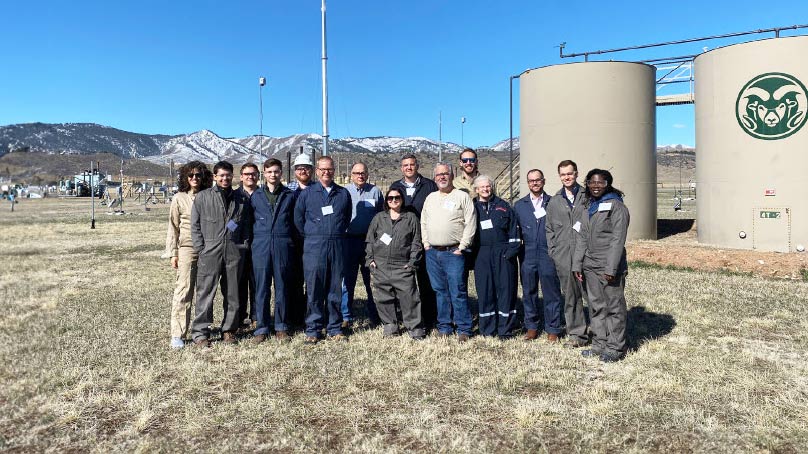Chubb 2024 Climate–Related Financial Disclosure

Addressing Climate Change Through a Science-Based Underwriting Approach
We are proud to present Chubb’s fourth annual TCFD Report, which reflects our ongoing work to manage our climate risks and opportunities and our evidence-based approach to addressing climate change. At Chubb, we remain firmly committed to encouraging the transition to a net zero economy while recognizing the ongoing energy needs of the global economy. We take thoughtful and innovative actions to support our clients in their efforts to transition to a net zero economy. In the eighteenth year of the Chubb Corporate Environmental Program, we continue to be guided by the same fundamental underwriting principles that underpin our business and by the best available climate science. We strive to create new ways to work with our clients and provide the essential risk transfer capacity necessary to support the net zero transition.
At Chubb, we actively review emerging climate change disclosure requirements and voluntary frameworks, in addition to complying with existing climate disclosure requirements. We have focused recently on the increasing global momentum towards the adoption of the International Sustainability Standards Board’s (ISSB) IFRS Requirements for Disclosure of Climate-Related Information. Our Sustainability Report provides information on how we have considered the ISSB and other reporting frameworks in developing our approach to disclosure. Overall, we believe that we and our stakeholders are best served by focusing our disclosures on financially material, business-relevant information. These principles guide both the scope of our disclosures in this report and our global engagement with regulators seeking comment on the adoption of climate disclosure frameworks.
Addressing Scope 3 Emissions
The fundamental purpose of insurance is to provide risk transfer capacity to ensure the efficient functioning of the global economy. Chubb is broadly exposed to global macroeconomic conditions, and it is important to emphasize both our role in the global economy and our limited ability to shape the net zero transition when considering the utility of Scope 3 greenhouse gas (GHG) emissions measurements and goals in the management of our business.
Stakeholders, including a number of regulators, have sought to require the quantification of scope 3 emissions based on the idea that if scope 3 emissions are measured, the financial industry can manage the economy to the net zero transition by allocating capital accordingly. There is one fundamental flaw with this theory: it simply doesn’t work.1
This should come as no surprise because financial institutions are not regulators and cannot singlehandedly set the course for the global economy. Financial institutions can only finance and insure net zero solutions if there is a market for them. At present, global energy demand continues to grow and global economic growth mandates that energy supply keep pace with demand. Policies that restrict investment or insurance capacity supporting the critical energy needs of the global economy will only serve to raise the cost of energy to businesses and consumers, and to distance large, publicly-traded financial institutions from key sectors of the economy that require support and investment to ensure energy security and affordable, reliable, and clean energy for all.
These issues are magnified when we narrow our focus to insurance. The short-term nature of insurance contracts means that we follow market conditions rather than shape them. At Chubb, we engage with our clients on opportunities to reduce emissions in their operations. We focus these efforts on high emitting industries and seek to promote the adoption of engineering controls or practices that directly reduce emissions.
Contrast this with current approaches to calculating “insurance-associated” Scope 3 emissions. Because these efforts look across an insurer’s entire book of coverage — or at least all clients in a particular sector — an estimate of insurance-associated emissions requires data from every single client. At present, this data is not actually available, so companies rely on estimates of emissions. While these estimates may at times go by technical-sounding names like “enriched” data sets, in reality they represent made up data that fails to provide meaningful insights into the conduct of the actual client and do not meet our standards for making business decisions.
Beyond questions of data availability, the Partnership for Carbon Accounting Financials (PCAF) methodology for applying that data to generate “insurance-associated” emissions is deeply flawed. We detail below the many ways in which the PCAF methodology can be distorting. The most fundamental issue is this: the use of an “attribution factor” by PCAF, based on a ratio of premium to revenues, strips “insurance-associated emissions” from any reasonable relationship they may have had to activity in the real economy. The pursuit of an insurance-associated emissions metric also risks diverting significant resources away from our focused work on engaging with clients in high-emitting industries, which we believe will generate greater value for our stakeholders and the net zero transition.
In light of these challenges, we believe that our holistic approach to GHG reduction will more effectively advance the transition than estimating insured emissions. Our approach focuses on several key areas discussed below:
- Chubb Climate+. Chubb Climate+ is Chubb’s global, interdisciplinary team of underwriters and engineers focused on providing essential risk management services to support the transition to a net zero economy. In May 2024, Chubb introduced a Climate Resilience Service Leader to develop services that help our customers understand their physical climate risks and capitalize on resilience opportunities. These services are underpinned by data and our expert engineering assessments to create actionable climate plans. More details on Chubb Climate+ can be found in the Strategy section of this report.
- Chubb ’s Underwriting Criteria. Since becoming the first global insurer to announce methane criteria for oil and gas extraction activities in 2023, we have continued to develop underwriting criteria for high-emitting industries. In addition to these criteria, our risk engineering teams provide on-the-ground engagement and support for our clients as they work to address their GHG emissions in the real economy. More details on the development of our underwriting criteria are in the Strategy section of this report.
- Supporting Thought Leadership on the Role of Insurance in the Net Zero Transition. We are proud to continue our industry leadership in encouraging a science-based approach to climate change, including through our collaboration with the University of Pennsylvania to facilitate dialogue between investors, regulators, insurance companies and other stakeholders regarding the role of the insurance industry in facilitating the transition to a net zero economy. We also continue to explore other opportunities to contribute to efforts by our regulators and with our peers to support the net zero transition and enhance climate resilience.
We understand that our investors seek information to quantitatively assess both our exposure to climate risks and our progress in facilitating the transition to a net zero economy. We believe that the most essential information we can provide relates to our efforts to grow our support of the transition activities of our clients through Chubb Climate+ and to assess our engagement efforts through our underwriting criteria. Further data on these efforts is provided in the Metrics and Targets section of this report.
(1) Sastry, Parinitha & Verner, Emil & Marqués-Ibáñez, David, 2024. “Business as usual: bank climate commitments, lending, and engagement,” Working Paper Series 2921, European Central Bank. https://www.ecb.europa.eu/pub/pdf/scpwps/ecb.wp2921~603e225101.en.pdf
Challenges with the PCAF Attribution Factor
PCAF relies on premium revenue and total reported GHG emissions to identify insurance-associated emissions. PCAF uses revenue exclusively, ignoring commonly used indicators such as total assets, total revenue or number of employees. This reliance on revenue alone is flawed in numerous ways, including because revenue fluctuates with general macroeconomic market movements unrelated to GHG emissions and because there are differences in how revenue is calculated across the world due to the differences in the reporting frameworks used by companies depending on their size and respective industry.
These factors, when considered separately and in combination, all mean that relying on revenue as a proxy for the importance of an insurance purchase made by a given company is inherently distorting. PCAF then calculates an insured’s proportionate responsibility for a company’s emissions by multiplying the company’s emissions by an attribution factor defined as premium divided by revenue. This reliance on premium is also flawed in numerous ways, including:
- Premiums fluctuate with insurance market hardening and softening cycles that are unrelated to GHG emissions.
- Premiums reflect an insurer’s assessment of an insured’s risk profile for perils covered by the policy, which may change for reasons unrelated to GHG emissions.
This can lead to nonsensical results under the PCAF framework:
For example, an insurer who sells a policy with a $200,000 premium to an early-stage mining company with $15,000 in revenue and a total reported GHG emissions inventory of 100,000 metric tons. Under the PCAF methodology, the “insured emissions” associated with this client would be:

Alternatively, the insured emissions for an insurer who sells a policy with a $1 million premium to a large tech company with $1 billion in revenue and a total reported GHG emissions inventory of 200,000 metric tons would be:

A Note on Emerging Climate Disclosure Frameworks
In the past year, Chubb closely monitored global climate disclosure regulatory developments including the Securities and Exchange Commission (SEC) Climate Disclosure Rules release (and related challenges). In general, we are concerned about the proliferation of disclosure requirements across numerous jurisdictions that are overly burdensome, duplicative or unduly focused on Scope 3 reporting, which fail to meaningly advance GHG reduction. We favor approaches that allow us to focus on financially material issues and facilitating the reduction of GHG emissions in the real economy over those that remain narrowly focused on counting or are overly reliant on estimation of data.
To encourage consistency and efficiency in climate reporting, Chubb supports the adoption of the ISSB and we anticipate the ISSB framework will become the prevailing disclosure standard. After reviewing alternative materiality metrics that apply to climate and sustainability reporting, such as the Corporate Sustainability Reporting Directive (CSRD) “dual materiality” approach, we continue to believe that financial materiality is the most appropriate approach to provide our stakeholders with information that is relevant to our business and our management of climate and sustainability risks.
This year, in accordance with the requirements of Article 964b of the Swiss Code of Obligations (CO), Chubb published its first annual Sustainability Report. Consistent with the requirements of Article 964b CO, this inaugural Sustainability Report begins with an overview of Chubb’s business model and a summary of our approach to sustainability. The Sustainability Report then includes specific sections addressing sustainability governance, environmental issues (including climate change), our development of a diverse and sustainable workforce, and our commitment to ethical business practices. The Sustainability Report was approved by Chubb’s shareholders at its May 2024 Annual General Meeting.
Outside of the regulatory context we continue to monitor developments in voluntary standards. The most notable recent development in this space is the release of the Science Based Targets Initiative’s (SBTi) second consultation draft for net zero standards for financial institutions. Unfortunately, SBTi’s rigid stance on fossil fuels remains at odds with the needs of the present energy economy. Under SBTi’s proposed approach, we would be required to immediately cease all investing and underwriting activity related to “long term” fossil fuel assets. This approach ignores the complexities of the energy transition and the fact that the global economy must both decarbonize and meet rising energy demand. While we believe that there is ample opportunity to engage with the energy industry on transition planning and actual measures that will reduce GHG emissions, meaningful engagement cannot be driven by an absolutist, exclusionary approach that fails to address the energy economy.
Chubb governance related to climate risk includes the oversight functions and active engagement of its Board of Directors, extensive involvement of its most senior executives, and its global enterprise risk management (ERM) framework.
Board of Directors Oversight
The Board of Directors recognizes the critical risks arising from climate change and is actively engaged in overseeing the company’s climate-related strategies, including the development of its climate policies and climate-related business activities. The Board and its committees receive regular updates on climate issues from management and external experts.
In addition to the full Board’s general oversight, two Board committees are charged with specific climate-related oversight responsibility:
- Risk & Finance Committee: oversees our ERM function, which includes extensive analysis of climate risk, including climate-related catastrophe risk, such as increased threats of wildfire, sea level rise and hurricane frequency and intensity, and reviews investment risks associated with climate change.
- Nominating & Governance Committee: oversees our corporate citizenship activities and environmental, social, and governance (ESG) policies and initiatives, including those relating to climate change and the environment, such as our fossil fuel-related underwriting and investment policies, corporate environmental goals and philanthropic efforts. The committee also receives updates and provides input on feedback from shareholders and other stakeholders on Chubb’s climate efforts.
Management Responsibilities
Chubb is engaged in a wide range of climate-related activities that include:
- Identifying and analyzing climate risk;
- Public engagement on climate issues with government officials, regulatory bodies, climate advocacy groups, climate experts and a variety of other interest groups;
- Consideration and implementation of appropriate climate-related underwriting and investment actions;
- Limiting the company’s own GHG emissions; and
- Providing philanthropic support for climate resilience projects.
Chubb’s CEO and its management Executive Committee provide oversight and direction of these activities and set the company’s climate-related strategies. The CEO engages extensively on climate issues, including in his annual shareholder letter and other public communications. Other senior executives with climate-related responsibilities include:
- The General Counsel coordinates the company’s ESG initiatives, including its climate-related policies and strategies.
- The Chief Risk Officer oversees the ERM function, including risks associated with climate change. Various management teams, including the Risk and Underwriting Committee, product boards and risk-related committees, meet regularly to evaluate specific risks and risk accumulation in Chubb’s business activities and investments.
- The Global Climate Officer is responsible for coordinating Chubb’s climate-related strategies and supporting the execution of business and public policy initiatives. The Global Climate Officer also oversees our internal climate activities, including GHG emissions measurement and reduction commitments.
Chubb believes the most effective use of its resources to support society’s transition to net zero is to provide our clients with the risk transfer capacity necessary to facilitate their transition efforts. Our climate strategy is underwriting-focused and consists of three main pillars: (1) applying our underwriting and engineering expertise to support the technologies that will promote the transition to the net zero economy, (2) promoting climate resilience through engineering and new service offerings, and (3) applying a science-based underwriting approach to develop technical underwriting criteria that encourage the adoption of controls and best practices in high-emitting industries.
Chubb Climate+: Underwriting for the Transition and Engineering for Resilience
In January 2023, we launched Chubb Climate+, our global climate practice. Chubb Climate+ focuses on facilitating and advancing a global transition to a net zero economy by expanding the company’s already market-leading position in the natural resources and Climate Tech industries. Chubb Climate+ provides a range of global solutions to support our clients in their transition to a net zero economy and increase their resilience to the physical impacts of climate change. The practice draws on Chubb’s extensive technical capabilities in underwriting and risk engineering, bringing together Chubb units engaged in traditional, alternative and renewable energy, climate tech and risk engineering services. Chubb Climate+ provides a broad spectrum of insurance products and services to businesses engaged in developing or employing new technologies and processes that support the transition to a net zero economy. It also provides risk management and resilience services to help those managing the impact of climate change. Our commitment to this endeavor is reflected in the scope of our Chubb Climate+ business: as of January 2024, Chubb insured one-third of the Global Cleantech 100. Chubb Climate+ is focused on growing our practice in renewable energy and Climate Tech.
Chubb Climate+ Climate Tech Occupancies
- Renewable & Alternative Energy
Companies supporting solar, wind, hydro, geothermal, biomass, hydrogen, biofuels, and nuclear
- Built Environment & Energy Efficiency
Building automation solutions, technology for efficient heating and cooling equipment, alternative materials, industrial processes, adaptation, and waste-water filtration technology
- Food & Agriculture
Vertical farming, ag tech, plant-based/cellular foods, crops engineering, low-carbon fertilizer, and aquaculture
- Transport & Mobility
Electric vehicles, EV component parts, charging stations and infrastructure, maritime decarbonization, aviation, micro-mobility, and contractors’ equipment
- Storage & Transmission
Batteries, alternative storage, fuel cells, smart grids, and transmission infrastructure
- Carbon Technology & Climate Finance
Carbon Capture Utilization and Storage, nature-Carbon Capture Utilization and Storage, nature-based solutions, carbon financial markets, venture capital, incubators, associations, research, and development firms supporting Climate resilience

Chubb risk engineers and underwriters engaged in a unique training experience at the renowned Methane Emissions Technology Evaluation Center (METEC) within Colorado State University Energy Institute.
Chubb has added to the capabilities of the risk engineering team by hiring specialists with climate, resilience, and adaptation experience, and also implementing significant efforts over the past year to upskill the broader Chubb Risk Engineering team to be able to engage with our insureds on a broad range of issues related to sustainability and climate. In March, fourteen of Chubb’s dedicated Oil and Gas Risk Engineers and Energy Underwriters participated in a two-day customized training program at the Methane Emissions Technology Evaluation Center (METEC) within Colorado State University Energy Institute. The training, which provided invaluable hands-on insights into cutting-edge methane detection technologies, leak sources, and abatement opportunities, further strengthens our Risk Engineering and Underwriting team’s deep technical knowledge within the oil and gas industry.
Additionally, in May 2024 we established Chubb Climate+ Resilience Services, a strategic service practice. Led by a dedicated Resilience Service leader, this practice combines strategic advisory capabilities with our extensive engineering expertise and forward-looking climate modeling to provide customers with comprehensive insights into their physical climate risk landscape, and actionable resilience recommendations to support strategic decision-making. By developing these strategic services in collaboration with broader business functions such as risk engineering, underwriting, and claims, Chubb Climate+ Resilience Services takes a comprehensive and innovative approach to helping customers and consumers maximize the opportunities arising from the global transition to a net zero economy.
Developing science-based underwriting criteria for high-emitting industries
Through Chubb’s underwriting process, we have opportunities to promote good risk management and the adoption of sound engineering practices by our clients. Our climate strategy seeks to deploy Chubb’s fundamental areas of expertise to address the high-emitting industries we insure. Our approach to these industries involves conducting our own review of best practices, seeking guidance from non-governmental organization (NGO) partners, and engaging with our clients to develop perspectives on GHG emissions mitigation measures that apply best engineering practices and relate to risk quality. As we develop underwriting criteria, we will simultaneously offer our on-the-ground engineering expertise, working on-site with our clients to help deploy best practices and controls to reduce GHG emissions.
We applied this approach to the development of our oil and gas underwriting criteria and we are currently evaluating the potential evidence to support the development of criteria in other high-emitting industries. We anticipate announcing criteria for additional high-emitting industries in the near term.
Oil and Gas Underwriting Criteria and Conservation Policy
In March 2023, Chubb introduced underwriting criteria and conservation criteria that applied to oil and gas extraction projects.2 In April of this year, we updated these criteria for larger oil and gas companies and announced new standards for midstream activities. Chubb’s climate underwriting criteria for oil and gas encompass:
Standards for methane emissions
- For oil and gas producers with annual revenues less than $1 billion, Chubb will continue to provide insurance coverage for clients that implement evidence-based plans to manage methane emissions, including, at a minimum, having in place programs for leak detection and repair, the elimination of non-emergency venting, and adopting one or more measures that have been demonstrated to reduce emissions from flaring. Clients will have a set period of time to develop an action plan based on their individual risk characteristics. We may decline coverage if a potential policyholder cannot meet our methane performance expectations.
- For oil and gas producers with annual revenues greater than $1 billion, Chubb expects our insureds will achieve a methane emissions intensity of 0.2% or less by 2030 across their global operations. Chubb will continue to provide coverage for clients that are able to report their methane emissions intensity, are engaging in direct measurement of methane emissions, and demonstrate progress towards achieving methane emissions intensity of 0.2% or less. We may decline coverage if a potential policyholder cannot meet our methane performance expectations.
- For midstream oil and gas operations with annual revenues greater than $1 billion, Chubb expects our insureds will achieve a methane emissions intensity of 0.2% or less by 2030 across their global operations. Chubb will continue to provide coverage for clients that are able to report their methane emissions intensity, are engaging in direct measurement of methane emissions, and demonstrate progress towards achieving near zero methane emissions intensity. We may decline coverage if a potential policyholder cannot meet our methane performance expectations.
- For midstream oil and gas operations with annual revenues less than $1 billion, Chubb will continue to provide insurance coverage for clients that implement evidence-based plans to manage methane emissions, including, at a minimum, having in place programs for leak detection and repair and the elimination of non-emergency venting and adopting one or more measures that have been demonstrated to reduce emissions from flaring. Clients will have a set period of time to develop an action plan based on their individual risk characteristics. We may decline coverage if a potential policyholder cannot meet our methane performance expectations.
We will support our clients as they endeavor to improve their methane emissions controls by providing resources and support through our risk engineering services. We have created and will continue to expand the Chubb Methane Resource Hub as a central location for resources and support for our insureds.
Coal Policy: Chubb was the first major insurer in the U.S. to announce a policy concerning thermal coal-related underwriting and investment. In 2019, we adopted the following policy:
- Chubb no longer underwrites risks related to the construction and operation of new coal-fired plants.
- Chubb does not underwrite new risks for companies that generate >30% of revenues from thermal coal mining and began phasing out coverage of existing risks that exceeded this threshold at the end of 2022.
- Chubb does not underwrite new risks for companies generating more than 30% of their energy production from coal and began phasing out coverage of existing risks exceeding this threshold at the start of 2022 (accounting for the viability of alternative energy sources in the impacted region).
- Chubb no longer makes new debt or equity investments in companies that generate more than 30% of revenues from thermal coal mining or that generate more than 30% of energy production from coal.
Given that our Coal Policy is now five years old, we are reviewing the policy and expect to provide an update before the end of the year.
Oil Sands Policy: In 2022, Chubb adopted a policy that it would no longer underwrite risks for projects involving direct mining or in-situ extraction and processing of bitumen from oil sands.
(2) A summary of Chubb’s full set of underwriting criteria, including conservation criteria can be found on our website at https://about.chubb.com/content/dam/chubb-sites/chubb/about-chubb/citizenship/environment/pdf/chubb-corporate-climate-underwriting-criteria-for-high-emitting-industries.pdf
Chubb Methane Resource Hub
To support our clients in their steps to improve their methane emissions controls, Chubb developed and launched the Chubb Methane Resource Hub in 2023. The goal of the hub is threefold:
- Educate and raise awareness for reducing methane emissions to drive near-term climate impact.
- Be a one-stop shop resource library for methane emissions thought leadership.
- Assist oil and gas companies with identifying vendors who have knowledge and expertise in detecting and managing methane emissions.
In 2024, Chubb updated the library with new content including interviews and discussions with our partners at the Environmental Defense Fund, new educational animations and videos, and new featured service providers.
Building off the success of the Chubb Methane Resource Hub, we look forward to expanding the climate resources we offer to our clients through the development of a hub focused on agriculture sustainability and resilience. Chubb’s agriculture clients include farmers, ranchers and agribusinesses, who each face unique exposure to extreme weather events. The new hub will be designed to support these clients in understanding the climate risks facing the agriculture sector and equip them with resources and guidance to adopt on-farm practices which can increase resilience and sustainability. Further details on the Agriculture Hub rollout are expected in the near term.
Assessing our exposure to climate risks
We consider a wide range of risks related to climate change, from the effect of increased wildfire and storm intensity on property claims to the potential effect that changing energy usage may have on the fossil fuel industry’s insurance demand. Underlying our physical climate change risk and resilience assessment is one fundamental fact about the insurance industry: most insurance policies are issued on an annual basis, meaning that we are able to quickly adapt our underwriting strategies to emerging climate risks. For example, we can respond to increased claims risk (e.g. from wildfires or hurricanes) with rates and geographic limitations on exposure that reflect that increased risk. It also means that we can quickly adjust our underwriting strategies to, for example, focus on new business opportunities in clean energy, as we are doing with Chubb Climate+.
As we manage climate risk, Chubb closely follows emerging trends in climate litigation. For example, the risk associated with “greenwashing” and “impact washing” — the false or misleading impression regarding the environmental and sustainability practices, policies, products, and activities of a company — is increasing, particularly with expanding regulatory focus. Alleged corporate greenwashing and other alleged ESG-related misrepresentations by companies from many sectors have received scrutiny by a wide range of interested parties. Chubb is monitoring these risks on its insurance products, in particular directors and officers (D&O) liability coverages and General Liability coverages. We continue to evaluate these risks in transition-exposed industries and have provided extensive training to our global D&O underwriters about the risks presented by climate change. We seek to manage our exposure through limits management, appropriate pricing and coverage terms.
We conduct extensive analysis of the risks related to how climate change may be altering the frequency and severity of natural catastrophe events. We maintain a large internal team of natural catastrophe modelers who regularly assess the potential for climate-driven changes in the frequency and severity of losses. We quantify these risks on an annual basis through the Probable Maximum Loss (“PML”) calculation, which is described in more detail below.
Our Enterprise Risk Unit supports Climate Change Scenario testing across Chubb’s global operations. The ERU is working to develop a unified approach to climate scenario analysis that can be applied across Chubb’s operations. The scenarios under assessment rely on the Intergovernmental Panel on Climate Change (IPCC) RCP4.5 and RCP8.5 scenarios for physical climate impacts, as well as multiple transition scenarios over short, medium and long-term timeframes, and the Network for Greening the Financial System (“NGFS”) scenarios for both transition and physical risks. We assess the impact of physical, transition and liability risks over modeled timeframes.
The IPCC has published several trajectories of global warming, which are used to inform scenarios assessed across the financial services industry. We are evaluating the IPCC’s extreme climate change scenario, RCP8.5, which represents a 4.5ºC temperature rise by the end of the century, to provide a broad range of outcomes. The impacts of this scenario are layered on our existing natural catastrophe perils. We have licensed the RMS (industry standard natural catastrophe model vendor) forward-looking climate views for U.S. hurricane, which is the largest contributor to our Worldwide Aggregate PML, and will be evaluating additional climate solutions for other key perils.
We also model, as required by regulators across our global operations, the impact of transition risk on the investment portfolio and assess liability risk based on exposure by sector. The assumptions for this modeling leverage NGFS published scenarios, which cover multiple transition and physical risk paths. Parameters are translated to specific investment portfolio related shock assumptions by country.
We work extensively to understand the potential climate impacts to our view of risk and to meet regulatory requirements. For near-term business planning decisions (less than one year), we confirm model appropriateness for current climate risks by endeavoring to appropriately incorporate recent trends, loss experience, and changing exposure patterns. For example, it appears that climate change has likely resulted in an increase in storm surge from sea level rise as well as an increase in tropical cyclone precipitation. Separately, there is also likely higher U.S. wildfire and inland flood risk. We have stress tested our U.S. wildfire model and the potential impacts of reduced precipitation/snowpack, and longer and more intense wind seasons. The results of this analysis have had a substantive impact on our business in certain U.S. western states, including how we view the evolving nature of wildfire risk in terms of concentrations of that risk in the wildland-urban interface. We have also been assessing the increasing incidence and severity of heatwaves and the impact across our various insurance products.
For long-term (five-plus years) impacts, we utilize vendor models to assess the impacts of the IPCC scenarios on modeled losses for key region perils such as U.S. hurricane, with a focus on the RCP8.5 scenario.
We also assess the impacts of climate change on our operations beyond natural catastrophes, for instance through the implications of regulatory, legislative and legal activity, and other market activity impacting our clients or the credit and market risk of our investment portfolio.
Our investment strategy focuses on asset allocation and relies on outside asset managers to direct securities selection and execution. Most of our investments are in bonds with maturities typically five years or less. As a result, individual portfolio holdings are constantly changing over time and are less impacted by the long-term effects and company-specific risks associated with climate change. Our asset managers are helping us understand their climate risk management strategies, how they are applied to our assets, and what data are available to us to understand the climate alignment of our investment portfolios. We are also implementing BlackRock’s Aladdin portfolio management software, which includes climate data oversight capabilities via integration with other third-party providers’ TCFD data metrics, and the Chubb Asset Management and Sustainability teams are currently exploring this data to prepare for invested emissions disclosure requirements for certain Chubb entities where such disclosure may become legally required in 2025. In addition, we are currently engaging with our asset managers to evaluate the best ways to collaborate in applying our climate underwriting criteria to the management of in-scope energy assets. We regularly evaluate opportunities to invest in funds and companies that target climate solutions, including in the areas of decarbonization, energy efficiency, resource conservation and emissions management. Further, we are actively working to determine how to best apply our climate underwriting criteria to our asset management practices. We plan to continue to seek opportunities in these areas that are consistent with our broader investment management objectives.
Seeking External Advice to Shape our Strategy
Chubb values the expertise and input of external collaborators as we continue to develop our climate strategy. We actively seek to build external partnerships and engage with our clients.
We continue to engage with the Environmental Defense Fund (EDF), a globally leading, science-focused, environmental NGO, and their experts in the oil and gas and insurance sectors. EDF provided technical expertise to support the identification and development of resources for the Chubb Methane Resource Hub to support our oil and gas clients in reducing their methane emissions. We have also been engaging with EDF experts in the development of resources on agricultural resilience that we expect to launch in the near term. We continue to develop further partnerships with other NGOs focused on the decarbonization of high-emitting industries to support our continued development of climate underwriting criteria beyond oil and gas. For the third consecutive year, we sponsored a series of workshops facilitated by the University of Pennsylvania to further the conversation between insurance companies, investors, regulators, emissions measurement groups, academics and other stakeholders around how the insurance industry can assess and track climate risk and opportunities and develop meaningful metrics to communicate progress. We plan to continue our sponsorship of workshops with Penn this year and in the future with the intention of connecting regulators, insurance companies and investors to continue the dialogue around facilitating the transition to a net zero economy and promoting climate resilience.
Over the coming year, identifying and formalizing partnerships will be critical in our approach to climate resilience services to drive conversation and innovation around climate risk & resilience.
Identifying and Assessing Climate-Related Risk
The consequences of climate change comprise numerous perils and hazards, and multiple risks and opportunities. Climate risk identification involves evaluation of the various risks to which Chubb is exposed as a result of our business profile and the external environment within which we operate. We provide an extensive description of our overall ERM process in Chubb’s 2024 Proxy Statement.
Chubb’s risk appetite is defined through risk guidelines, authorities, and policies and drives underwriting and risk mitigation actions. Natural catastrophe risk is managed through risk tolerances across multiple measures (capital, earnings, liquidity, industry loss share) to serve various objectives, and encompasses our exposure across all worldwide peril regions. As climate change and weather patterns drive the size of our exposure to natural catastrophe risk, we have performed extensive analysis to understand potential impacts on our assessment of the risk. In case of perils such as wildfire, where there is likely impact of climate change on the risk, we adjust our models to account for recent trends and apply a forward-looking view of the risk. We also determine the need for underwriting actions to manage exposure in concentration zones. In addition, we have issued policies limiting exposure to coal and oil sands.
ERM efforts are defined in terms of time horizon and business materiality. Chubb’s ERM discipline is defined as the process to identify, assess, mitigate and monitor those risks that, if manifested, might impact Chubb’s exposure footprint (investments, operations, and short/long-tail liabilities) such that our ability to achieve our strategic business objectives might be impaired. Chubb considers 36 months as the period during which we conduct our strategic ERM planning, but actual execution, and risks associated with that execution, has a one-to-two-year focus (short-term). Medium-term time horizons are two-to-five years, and long-term is five-plus years.
Catastrophe Modeling. Chubb evaluates and manages its exposure to natural catastrophes (and therefore physical climate risks) through the use of catastrophe modeling. Increased catastrophe losses in recent years highlight the increasing vulnerability of the ever-growing concentration of humans and property values on coastlines and in the urban-wildland interface. The very presence of human and property assets in such areas means extreme weather conditions can quickly turn into catastrophes.
Chubb is a leader in the use of catastrophe models to quantify natural catastrophe risk for product pricing, risk management, capital allocation and estimation of losses. Chubb uses models to aggregate and closely monitor natural catastrophe exposures across our global portfolio and to ensure our capital base is sufficient to meet the expectations of regulators, rating agencies, and policyholders, and to provide shareholders with an appropriate risk-adjusted return.
Chubb uses internal and external data together with sophisticated analytical, catastrophe loss and risk modeling techniques to contribute to an appropriate understanding of risk, including diversification and correlation effects, across different product lines and territories. We continually adjust our processes to address climate and weather pattern changes.
Chubb’s risk analysis ranges from the known (based on definitive historical loss experience) to the hypothetical (based on a probable maximum loss calculation). At present, our scenario analyses are modeled on a one-year time horizon to inform underwriting and business planning decisions, though we stress test our portfolio against multiple climate scenarios over a longer timeframe, as described in the Strategy section of this report. We continually assess and improve our modeling capabilities by utilizing our own loss experience, leveraging industry loss experience and expertise, as well as through academic partnerships. Through these efforts, we remain at the leading edge of assessing trends in frequency and severity of natural perils such as wind, flood and wildfire, and therefore incorporate them in a timely manner into pricing, underwriting and risk management decisions.
PML
Chubb uses probable maximum loss calculations to estimate the loss, in millions of dollars and translated to percentage of shareholders’ equity, that would occur from modeled natural catastrophes in a given year. With advanced modeling and the knowledge of internal and external scientists, we calculate the potential of different types of natural catastrophes to occur in one year and the likely dollar amount of claims should they occur. As part of this exercise, Chubb uses internal and external data together with sophisticated, analytical catastrophe loss and risk modeling techniques to ensure an appropriate understanding of risk, including diversification and correlation effects, across different product lines and territories.
Absolute dollar amounts of PML may change over time with increased market share and premium written, but we endeavor to keep consistency in PML as a percentage of total shareholders’ equity by managing our portfolio of business to handle expected losses. Because we have captured current-day impacts of climate change into our catastrophe modeling, and iteratively assess such impacts, PML calculations demonstrate business readiness to absorb physical losses from climate change. The table below presents our modeled pre-tax estimates of natural catastrophe PML, net of reinsurance, as of December 31, 2023, and does not represent our expected catastrophe losses for any one year. The PML is a reflection of our exposure to physical climate impacts on our insureds during the policy period and provides us with a tool to identify and manage the risks from those exposures. Please see our Annual Report for additional information on Chubb’s PML and catastrophe management.

Modeled Net Probable Maximum Loss (PML) Pre-tax
(As reported in the Chubb Limited 2023 Annual Report)
(1)Worldwide aggregate is comprises losses arising from tropical cyclones, convective storms, earthquakes, U.S. wildfires, and floods in the U.S., Canada, and Europe, and excludes “non-modeled” perils such as man-made and other catastrophe risk, including pandemic.
(2)U.S. hurricane losses include losses from wind, storm-surge, and related precipitation-induced flooding.
Managing Climate-Related Risk
Chubb employs a variety of tools and strategies to manage climate-related risks in our business operations. These range from fundamental features of the underwriting process to specific exclusions and underwriting criteria that address certain high-emitting industries.
With respect to the core underwriting process, there are several key risk management tools we employ that apply to all risks, including climate risks. First, as explained in the Strategy section above, our relationships with our insureds are typically governed by one-year contracts.
Consequently, we can quickly respond to changes as needed by adjusting our pricing or by restricting our exposure. As part of its typical underwriting process, Chubb regularly assesses the nature of the risks we are covering, including assessing changes in the insured, its operations and exposures that will naturally extend to climate risks. In addition, we mitigate our exposure to climate change risk by hedging catastrophe risk in both the reinsurance and capital markets.
Beyond these ordinary-course underwriting practices, we apply a number of underwriting criteria and exclusions that set forth specific underwriting practices for certain high-emitting industries as detailed in the Strategy section of this report.
Investment Management. We apply the same risk management rigor to our broadly diversified fixed income investment portfolio as we do to our underwriting practice. Our portfolio, which backs the loss reserves and claims-paying ability of our insurance businesses, is highly diversified by risk, industry, location, and type and duration of security. For example, asset concentrations are carefully managed in hurricane- and flood-exposed areas. The impact of climate risk on underlying credits will naturally be an increased factor in our investment decision-making over time given the future impact on certain long-dated asset classes, such as mortgages and municipal bonds. Our portfolio has an average duration of less than four years.
Risk Engineering. Chubb’s more than 600 risk engineers work with our commercial and consumer clients to moderate the risks from climate change perils and make them more resilient. The company brings deep technical knowledge to this work, from providing guidance on construction standards, wildfire land management, and coastal protection to the development of lithium battery storage systems. We advise policyholders in catastrophe-prone areas of potential mitigation and adaptation actions that could help reduce their risk exposure. Chubb also provides risk engineering services to help clients mitigate supply chain and global operations risks from exposures related to a changing climate. For example, Chubb provides wildfire mitigation consultation (such as vegetation management evaluations with geo-mapping and drone-based tools) to businesses and homeowners at elevated or increasing risk from wildfires.
Metrics and Targets
Insuring the Transition. Chubb Climate+ supports a variety of renewable energy projects as well as battery energy storage, renewable natural gas, development of alternative materials, and lithium battery component manufacturing.
During calendar year 2023, Chubb Climate+ achieved overall global growth of 32%. We evaluate the growth of our climate-related underwriting in two different ways:
- Chubb Climate+ Premiums: This value includes business we wrote in renewable energy and Climate Tech in the year. For 2023, the total global premiums written by Chubb Climate+ were approximately $360 million. For the first half of 2024, global written premiums in renewable energy and Climate Tech were approximately $253.7 million.
- Energy and Climate Premiums: This value includes premiums for Chubb Climate+ as well as from our global energy book. Given the dramatic transitions underway in the global energy industry and the significant investments our traditional energy clients are making to pursue decarbonization and new energy technologies, we find this metric to be useful in assessing our broader exposure to the energy transition. For 2023, our total global Energy and Climate premiums were approximately $1.85 billion. For the first half of 2024, our total Energy and Climate premiums were approximately $813.3 million, up 17% for the same time period year over year.
Further, Chubb tracks the growth of specific segments within Chubb Climate+. From June 2023 to June 2024, global written premiums written for Climate Tech increased 66%. Similarly, global written premiums for Renewable Energy and Alternative Fuels increased 21% year over year.
Engaging on Methane. As discussed in the Risk Management section of this report, Chubb first introduced underwriting criteria for oil and gas producers in 2023 and from July 2023 to July 2024 we engaged with 235 regarding our methane criteria as part of the renewal process. The key outcomes of these global engagements were:
- 205 clients had leak detection and repair (LDAR) plans in place or comply with Canadian provincial regulations requiring leak detection and repair.
- 207 clients provided us plans to eliminate routine venting.
- 206 clients provided us with plans to manage flaring.
For the clients who do not currently have an LDAR Plan in place, Chubb offers risk engineering services and informs the client that they will not be renewed if an evidence-based LDAR Plan is not enacted by their next applicable renewal.
Our underwriting criteria announced in 2024 for clients with greater than $1 billion in revenue requires our insureds to achieve a methane emissions intensity of 0.2% or less by 2030 across their global operations. We have begun to engage with our clients subject to these criteria and we anticipate sharing the outcomes of those engagements in future reports.
Greenhouse Gas Emissions
Since 2015, Chubb has purchased renewable energy as the source of electricity for our real estate portfolio in the U.K. and since 2022, for every country in which we operate where renewable electricity credits are reasonably available. In 2023, renewable energy and renewable electricity credit purchases reduced Chubb’s Scope 2 GHG emissions by 27,586 metric tons of CO2e.
Chubb’s annual GHG inventory covers our Scope 1, Scope 2 and certain categories of Scope 3 emissions. In 2019, we established a goal off a 2016 baseline to reduce our Scope 1 and Scope 2 emissions 40% by 2025. We surpassed this goal as of year-end 2021. Chubb seeks to purchase renewable energy in every country in which we operate where renewable energy is available for purchase and reasonably priced. Chubb’s remaining Scope 1 and Scope 2 emissions are from direct burning of fossils fuels by company owned vehicles and purchase of electricity in locations where renewable energy is not reasonably available. We anticipate setting new Scope 1 and 2 targets before the end of the year.
As part of Chubb’s core climate strategy, we seek to reduce or avoid entirely the purchase of carbon offsets, and instead invest in emissions reductions and the direct purchase of renewable energy where possible. Further, we are actively engaged in identifying ways to reduce emissions directly related to our products and services. Chubb recognizes that directly reducing emissions in our value chain is significantly more challenging and complex than simply purchasing carbon offsets, but we are committed to identifying ways to create emissions reductions in the real economy.
The GHG Emissions data reported on the following page covers fiscal year 2023. Chubb uses methodology based on the World Resources Institute and the World Business Council for Sustainable Development (WRI/ WBCSD) GHG Protocol for data collection and analysis for Scope 1, Scope 2 and some Scope 3 GHG emissions.
We also share our GHG emissions in our annual Sustainability Report.
Looking Ahead
Chubb is pleased to use this TCFD Report to share our progress over the past year. As detailed in this report and our annual Sustainability Report, we will continue to support the transition to a net zero economy by focusing on growing Chubb Climate+, pursuing new opportunities to enhance client resilience, and continuing the development of underwriting criteria for high-emitting industries. We plan to continue combining the development of new criteria with engineering support to assist our clients.
| GHG Emissions Metric | Definition of Metric | Metric Quantity |
|---|---|---|
| Scope 1 Emissions | Direct emissions from stationary and mobile combustion of fuels, and refrigerants | 23,017 mtCO2e |
| Scope 2 Emissions (market-based) | Indirect emissions from purchased electricity, steam, and chilled water (market-based) | 8,530 mtCO2e |
| Scope 2 Emissions (location-based) | Indirect emissions from purchased electricity, steam, and chilled water (location-based) | 36,116 mtCO2e |
| Scope 3 Emissions (business travel) | Indirect emissions from rail and commercial air travel and chartered aircraft | 18,811 mtCO2e |
We commissioned an external third party to perform limited assurance procedures with respect to certain of our greenhouse gas (GHG) emissions metrics for the year ended December 31, 2023. Refer to the Report of Independent Accountants and our Management Assertion for full details and data methodology.
Chubb Responses to NAIC Closed-End Questions
| NAIC Survey Question | Chubb Response | Reference(s) |
| 2. Does the insurer have publicly stated goals on climate-related risks and opportunities? | Yes | See generally: “Strategy,” Pages 6-10 |
| 3. Does your board have a member, members, a committee, or committees responsible for the oversight of managing the climate-related financial risk? | Yes | See: “Board of Directors Oversight” and “Management Responsibilities,” Page 4 |
| 4. Does management have a role in assessing climate-related risks and opportunities? | Yes | See: “Management Responsibilities,” Page 4 |
| 5. Does management have a role in managing climate-related risks and opportunities? | Yes | See: “Management Responsibilities,” Page 4 |
| 6. Has the insurer taken steps to engage key constituencies on the topic of climate risk and resiliency? | Yes | See: “Chubb Climate+: Underwriting for the Transition and Engineering for Resilience,” Page 5 “Developing science-based underwriting criteria for high-emitting industries,” Page 6 “Seeking External Advice to Shape our Strategy,” Page 9 |
| 7. Does the insurer provide products or services to support the transition to a low carbon economy or help customers adapt to climate risk? | Yes | See: “Chubb Climate+: Underwriting for the Transition and Engineering for Resilience,” Page 5 “Developing science-based underwriting criteria for high-emitting industries,” Page 6 |
| 8. Does the insurer make investments to support the transition to a low carbon economy? | Yes | See: Page 9, 12 |
| 9. Does the insurer have a plan to assess, reduce or mitigate its greenhouse gas emissions in its operations or organizations? | Yes | See: Pages 12-13 |
| 10. Does the insurer have a process for identifying climate-related risks? | Yes | See: “Identifying and Assessing Climate-Related Risk,” Page 10 |
| 11. If yes, are climate-related risks addressed through the insurer’s general enterprise-risk management process? | Yes | See generally: “Governance,” Page 4 “Risk Management,” Pages 10-11 |
| 12. Does the insurer have a process for assessing climate-related risks? | Yes | See: “Assessing our exposure to climate risks” under “Strategy,” Pages 8-9 “Identifying and Assessing Climate-Related Risk” under “Risk Management,” Page 10 |
| 13. If yes, does the process include an assessment of financial implications? | Yes | See: “Probable Maximum Loss Calculation” under “Risk Management,” Page 11 |
| 14. Does the insurer have a process for managing climate-related risks? | Yes | See: “Managing Climate-Related Risk” under “Risk Management,” Pages 11 |
| 15. Has the insurer considered the impact of climate-related risks on its underwriting portfolio? | Yes | See generally: “Risk Management,” Pages 10-11 |
| 16. Has the insurer taken steps to encourage policyholders to manage their potential climate-related risks? | Yes | See: “Chubb Climate+: Underwriting for the Transition and Engineering for Resilience,” Page 5 “Developing science-based underwriting criteria for high-emitting industries,” Page 6 |
| 17. Has the insurer considered the impact of climate-related risks on its investment portfolio? | IN PROCESS | See: Pages 9-11 |
| 18. Has the insurer utilized climate scenarios to analyze their underwriting risk? | Yes | See: “Catastrophe Modeling” under “Risk Management,” Page 10 |
| 19. Has the insurer utilized climate scenarios to analyze their investment risk? | Yes | See: “Assessing our Exposure to Climate Risks,” Page 8 |
| 20. Does the insurer use catastrophe modeling to manage your climate-related risks? | Yes | See: “Catastrophe Modeling” under “Risk Management,” Page 10 |
| 21. Does the insurer use metrics to assess and monitor climate-related risks? | Yes | See: “Metrics and Targets,” Pages 12-13 |
| 22. Does the insurer have targets to manage climate-related risks and opportunities? |
Yes | See: “Metrics and Targets,” Pages 12-13 |
| 23. Does the insurer have targets to manage climate-related performance? | Yes | See: “Metrics and Targets,” Pages 12-13 |
About This Report
The Chubb Corporate Environmental Program is now in its 18th year. The company has long been committed to communicating important information about its environmental initiatives to our clients, shareholders, employees, business partners, the communities where we operate, and others who have an interest in our company, our industry, and the environment. This report is the fourth issued by Chubb since we began reporting using the Task Force on Climate-Related Financial Disclosures (TCFD) framework in 2021. We also publish an annual Sustainability Report.
This report also constitutes Chubb’s responses on the U.S. National Association of Insurance Commissioners’ Climate Risk Disclosure Survey and reflects Chubb’s views and actions with respect to climate risk management and climate strategy.
We are committed to supporting our clients as they navigate a transition to a low-carbon economy, and we are actively supporting this transition across our company through the products and services we offer, our underwriting and investment decisions, our philanthropic support, and our public engagement on critical climate issues. This report provides insight into where we are and where we are going.
About Chubb and Our Business Model
Chubb Limited is the Swiss-incorporated holding company of the Chubb Group of Companies. Chubb Limited and its direct and indirect subsidiaries are a global insurance and reinsurance organization. With operations in 54 countries and territories, Chubb is a world leader in insurance and provides commercial and consumer property and casualty (P&C), accident and health (A&H), reinsurance, and life insurance to a diverse group of clients. We provide commercial insurance products and service offerings such as risk management programs, loss control, and engineering and complex claims management. We provide specialized insurance products ranging from Directors & Officers (D&O) and financial lines to various specialty-casualty and umbrella and excess casualty lines to niche areas such as aviation and energy. We also offer consumer lines insurance coverage including homeowners, automobile, valuables, umbrella liability, and recreational marine products. In addition, we supply A&H and life insurance to individuals in select countries. We serve multinational corporations and mid-size and small businesses with property and casualty insurance and risk engineering services; affluent and high net worth individuals with substantial assets to protect; individuals purchasing life, personal accident, supplemental health, homeowners, automobile in certain international markets and for high net worth individuals in the U.S., and specialty personal insurance coverage; companies and affinity groups providing or offering accident and health insurance programs and life insurance to their employees or members; and insurers managing exposures with reinsurance coverage. Chubb operates through six business segments: North America Commercial P&C Insurance, North America Personal P&C Insurance, North America Agricultural Insurance, Overseas General Insurance, Global Reinsurance, and Life Insurance. Chubb Limited is listed on the New York Stock Exchange (NYSE: CB) and is a component of the S&P 500 index. Chubb maintains executive offices in Zurich, New York, London, Paris, and other locations, and employs approximately 40,000 people worldwide.
Additional information can be found at: chubb.com
Published August 2024
The data contained in this report is for general informational purposes only. Investors are cautioned that certain statements in this report are forward-looking statements as defined in the Private Securities Litigation Reform Act of 1995. These statements often use words such as “estimate,” “expect,” “intend,” “plan,” “believe,” and other words and terms of similar meaning, or are tied to future periods in connection with a discussion of future operations or performance. These statements include, among other things, statements about our investment portfolio, our new product offerings, our market risk, our risk management, including climate-related risks and opportunities, as well as catastrophe losses and modeling, and commitments. No warranty, guarantee, or representation, either expressly or implied, is made as to the correctness or sufficiency of any material contained herein. Forward-looking statements are subject to certain risks, assumptions, and uncertainties, and actual events and results may differ materially from those expressed, envisioned or discussed herein. We undertake no obligation to update such forward-looking statements. For a discussion of the assumptions, risks, uncertainties, and other important factors that could cause actual results to differ materially from those expressed in the forward-looking statements, see our most recent reports on Form 10-K and Form 10-Q filed with the Securities and Exchange Commission.
The inclusion of information in this report should not be construed as a characterization regarding the materiality or financial impact (or potential impact) of that information.
This report contains trademarks, trade names and service marks owned by Chubb Limited and its subsidiaries, including Chubb® and Chubb logo®. In addition, this report contains trademarks, trade names or service marks of companies other than Chubb, which belong to their respective owners.











